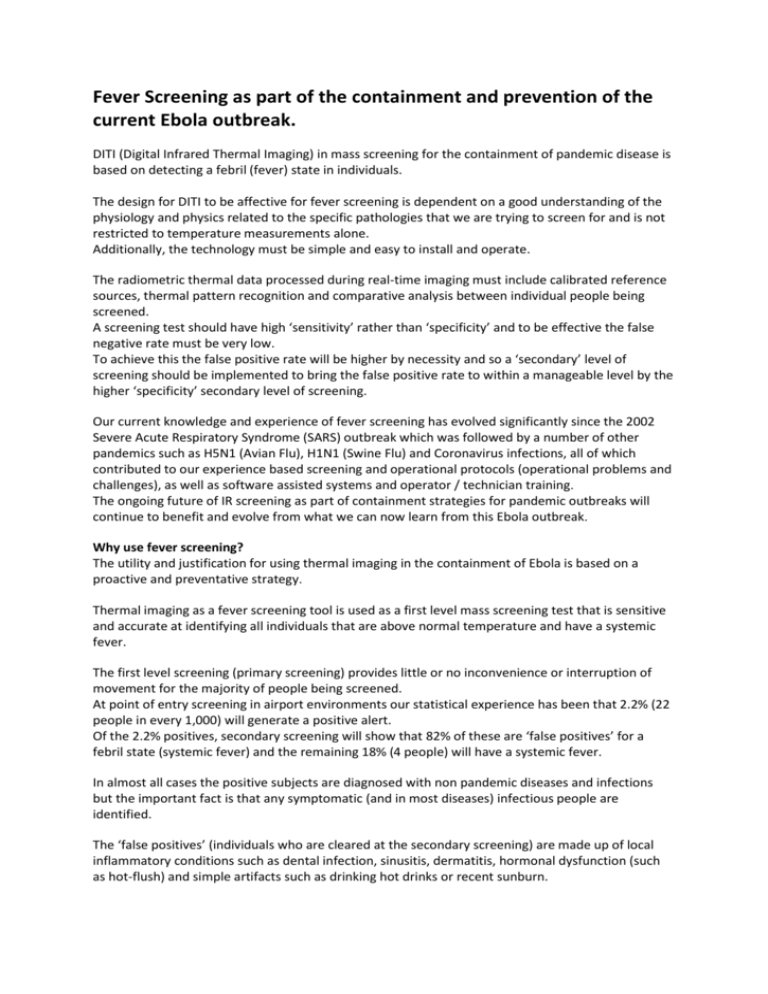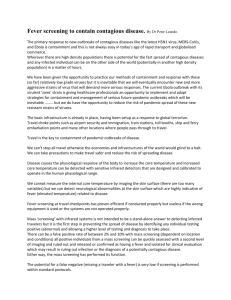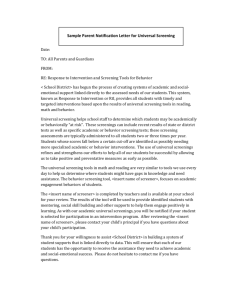Meditherm Media Release Ebola Screening
advertisement

Fever Screening as part of the containment and prevention of the current Ebola outbreak. DITI (Digital Infrared Thermal Imaging) in mass screening for the containment of pandemic disease is based on detecting a febril (fever) state in individuals. The design for DITI to be affective for fever screening is dependent on a good understanding of the physiology and physics related to the specific pathologies that we are trying to screen for and is not restricted to temperature measurements alone. Additionally, the technology must be simple and easy to install and operate. The radiometric thermal data processed during real-time imaging must include calibrated reference sources, thermal pattern recognition and comparative analysis between individual people being screened. A screening test should have high ‘sensitivity’ rather than ‘specificity’ and to be effective the false negative rate must be very low. To achieve this the false positive rate will be higher by necessity and so a ‘secondary’ level of screening should be implemented to bring the false positive rate to within a manageable level by the higher ‘specificity’ secondary level of screening. Our current knowledge and experience of fever screening has evolved significantly since the 2002 Severe Acute Respiratory Syndrome (SARS) outbreak which was followed by a number of other pandemics such as H5N1 (Avian Flu), H1N1 (Swine Flu) and Coronavirus infections, all of which contributed to our experience based screening and operational protocols (operational problems and challenges), as well as software assisted systems and operator / technician training. The ongoing future of IR screening as part of containment strategies for pandemic outbreaks will continue to benefit and evolve from what we can now learn from this Ebola outbreak. Why use fever screening? The utility and justification for using thermal imaging in the containment of Ebola is based on a proactive and preventative strategy. Thermal imaging as a fever screening tool is used as a first level mass screening test that is sensitive and accurate at identifying all individuals that are above normal temperature and have a systemic fever. The first level screening (primary screening) provides little or no inconvenience or interruption of movement for the majority of people being screened. At point of entry screening in airport environments our statistical experience has been that 2.2% (22 people in every 1,000) will generate a positive alert. Of the 2.2% positives, secondary screening will show that 82% of these are ‘false positives’ for a febril state (systemic fever) and the remaining 18% (4 people) will have a systemic fever. In almost all cases the positive subjects are diagnosed with non pandemic diseases and infections but the important fact is that any symptomatic (and in most diseases) infectious people are identified. The ‘false positives’ (individuals who are cleared at the secondary screening) are made up of local inflammatory conditions such as dental infection, sinusitis, dermatitis, hormonal dysfunction (such as hot-flush) and simple artifacts such as drinking hot drinks or recent sunburn. The benefits of covering points of entry with thermal fever screening are : 1 2 3 4 Containment. Reassurance for other travelers that could be exposed Deterrent to individuals considering traveling with undiagnosed symptoms of fever Flexibility in escalation of screening protocols due to level of risk. The opportunities for deployment of screening include: Airports and border checkpoints Docks and ferry / cruise terminals Points of entry / Points of exit Hospitals Military bases Government buildings Any large gatherings / conferences / meetings in public places. Challenges; Variable Incubation period, Highly contagious, High mortality, Virulent strain. Advantages: Infectious state accompanied by substantial fever. Climate sensitive, bodily fluids transmitted, not carried or transmitted via interspecies.






